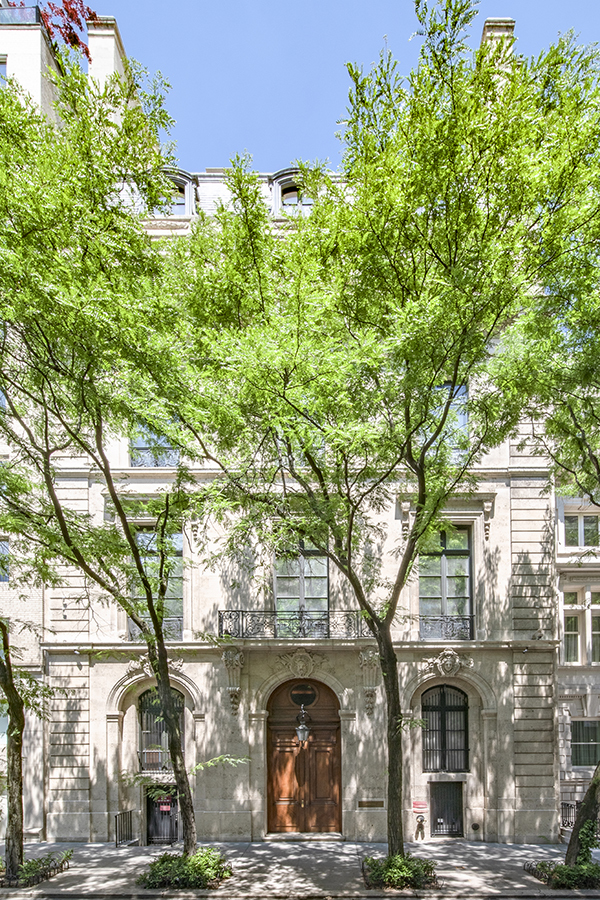
Someone who wishes to remain anonymous, sent me photos this weekend of the 9 East 71st Street townhouse when it was published in Architectural Digest in 1995 after they read my Friday Bon Weekend blog post. At the time it was owned by billionaire businessman Leslie Wexner who had architect Thierry Despont and interior designer John Stefanidis convert it from a private school to private home. Alberto Pinto would later redecorate for Jeffery Epstein. This magazine feature and recent real estate listing led me down a rabbit hole of researching more about the history of the townhouse, its owners, the architecture, and decoration. I was slightly hesitant to write about this infamous townhouse in detail but as the friend who sent the photos said, it includes work by “three of the greatest aesthetes of the 20th-century” and is an important piece of design history.

The property of 7-9 East 71st Street was purchased in 1928 by Herbert N. Straus, heir to Isidor and Ida Straus, co-owners of renowned retailers R. H. Macy & Co., who died on the Titanic. He commissioned “Society Architect” Horace Trumbauer, who built one of the largest and most luxurious residences of the times on the most desirable block on the Upper East Side which included the Frick Mansion across the street. (Horace Trumbauer also designed Clarendon Court in Newport, Rhode Island which was home to Sunny and Claus von Bülow. Make of that what you will.) This new home would replace an earlier home on the site, the Edward H. Van Ingen house built c. 1888.
No expense was spared on the 50 foot-wide six story townhouse which included imported French-limestone meticulously decorated with carvings, sculpture figures and ornamental iron works. Antiques and fixtures were bought in Europe along with “entire 18th-century rooms” to be installed in the home. But then the stock market crashed in 1931 and although the it was almost finished work was stopped. It’s interesting that it’s still known historically as the Herbert N. Straus building since he died of a heart attack and never actually lived in the home.
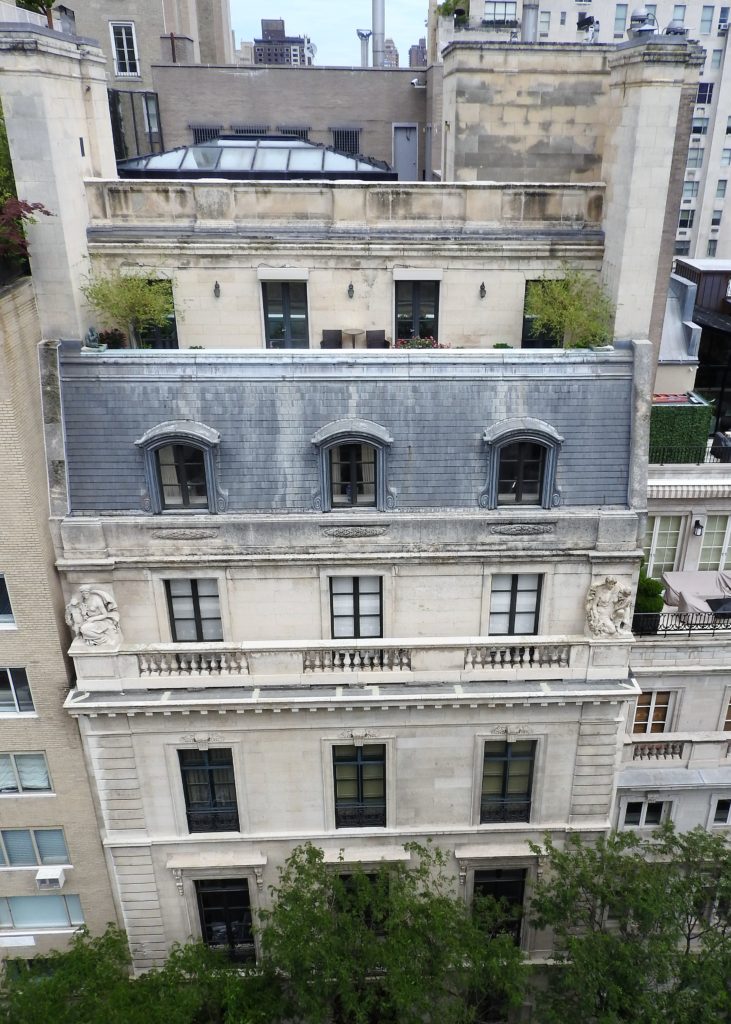
The original mansion was only six stories but Les Wexner would have a seventh story added on which you can see here. The large structure on the top right probably houses the elevator motor room while the mechanics for the house are probably housed behind it.
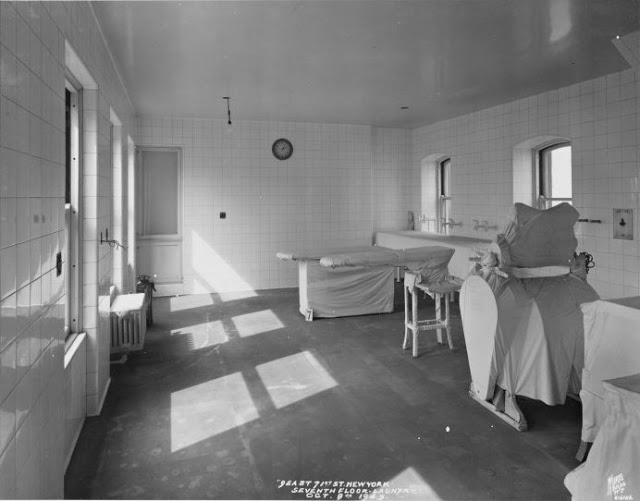
The mansion sat empty for almost a decade and would eventually be acquired in 1944 by the Roman Catholic Archbishopric of New York to become an extension of the St. Claire Hospital and in 1962. The Daytonian in Manhattan blog has a full account of what happened during this time period.
“Between $250,000 and $300,000 was spent on the renovation by architect Robert J. Reiley and the equipping of the new hospital. Thankfully, at least two of the 200-year old interiors from France were removed and reinstalled in the Metropolitan Museum of Art’s period room collection.” They include Room from a hotel in the Cours d’Albret, Bordeaux c. 1785, and Grand Salon from the Hôtel de Tessé, Paris c. 1768-72 which can be seen in the Wrightsman Galleries.
“The facility was opened on September 8, 1945. The ground floor now housed a Romanesque-style chapel hung with 16th century Genovese red velvet donated by staff member Dr. John Morrisey. The Louis XV reception room remained as did the dining room and library. Administrative offices were also on the first floor. In the basement were a modern kitchen and the nurses’ dining room.”
“Gleaming white tiles now lined the walls of the upstairs rooms. Two elevators carried patients to the new roof terrace where they could look out at Central Park.”
Th photo from 1943 above says it’s the “7th floor laundry from door at S.E. corner looking N.W.” which is weird since it was only six stories at that time. You can see more photos of the townhouse from 1943 here.
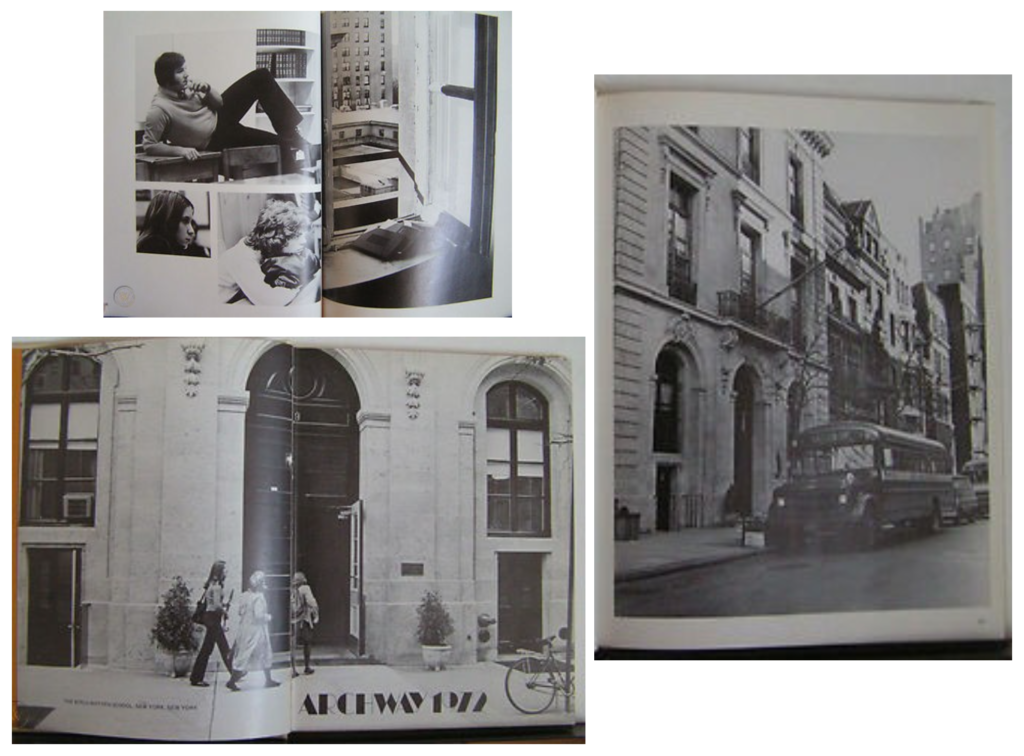
St. Clare’s closed their doors on July 24, 1961. The building was purchased by the Birch Wathen School, a college preparatory day school for well-to-do boys and girls from kindergarten through grade 12. The school would remain here for over two decades before moving uptown to 210 East 77th Street and becoming the Birch Wathen Lenox School.
In 1989, it was purchased for $13.2 million by the billionaire businessman the Leslie Wexner, the founder and chairman emeritus of Limited Brands, now known as L Brands. Wexner grew a business empire after starting The Limited, a clothing retailer with a restricted selection of profitable items, and later expanded his holdings to include Victoria’s Secret, Abercrombie and Fitch, Express, and Bath & Body Works.
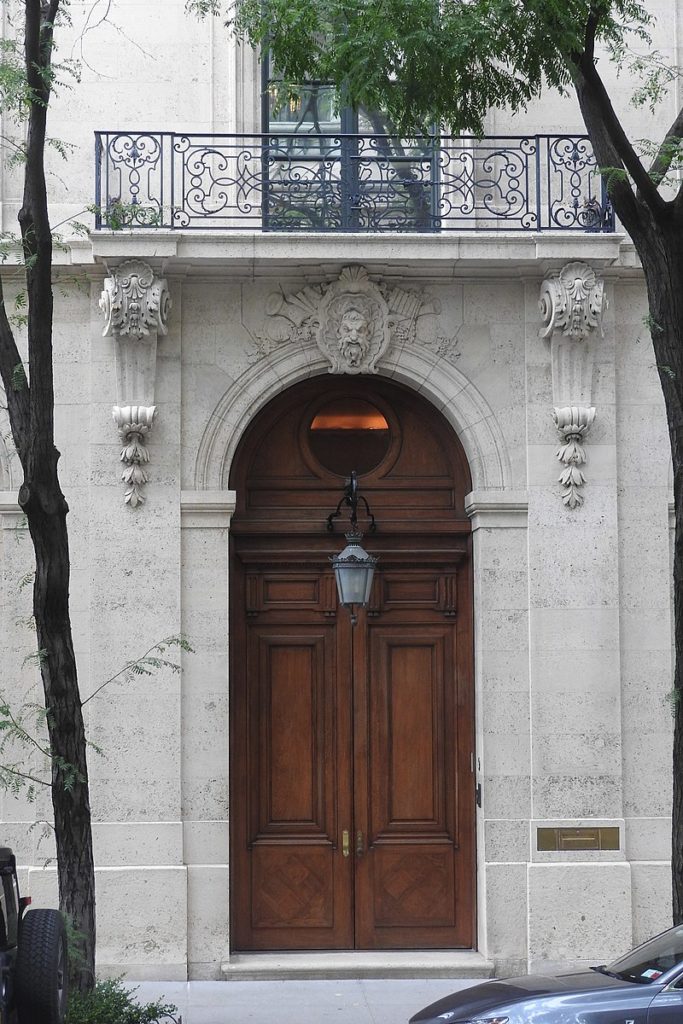
Les Wexner hired architect Thierry Despont and interior designer John Stefanidis to convert the townhouse back into the ultimate private residence. For the first time in half a century the magnificent French Renaissance mansion would be a home. Except Wexner never lived there. An advisor to the millionaire told The New York Times in 1996 that he spent no more than two months in the house. In 1993, Wexner married Abigail Koppel, a 31 year old lawyer, and the newlyweds relocated to Ohio where she thought it would be better to raise children.
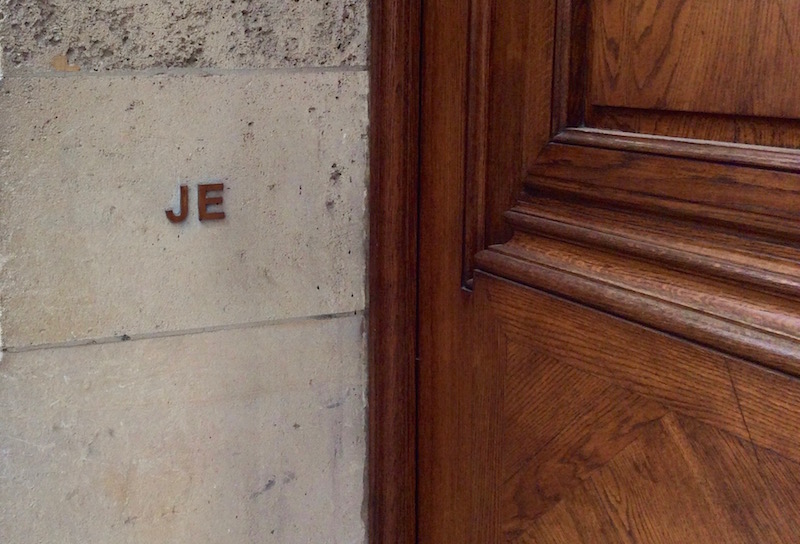
In 1996, Jeffrey Epstein moved into the townhouse and Les Wexner later transferred the deed to him without receiving any payment. There is a lot of speculation as to why this might have happened and also how Epstein made his fortune. Writer Vicky Ward outlines much of his life and work in her article, The Talented Mr. Epstein, that was published in Vanity Fair magazine in March 2003. She is also featured in the four-part documentary Jeffrey Esptein: Filthy Rich on Netflix where she states that she was threatened by Epstein that something might happen to her if Epstein didn’t like the article. The interviews with some of his victims were taken out of her article after others were threatened.
It’s clear from both of these sources that he started out in life as a liar and grifter who never changed his ways. After dropping out of college, he lied on his application to teach at the Dalton School in the 1970s and was later fired from this job and others in finance. In the documentary, there is footage of Les Wexner giving a speech in 2019 where he talks about bwing taken advantage of by someone which was most certainly Epstein. Someone else said Epstein stole $46 Million from Lexner.
Some recent theories to arise are that Epstein “belonged to intelligence” which is what led to the plea deal in 2007 and that he a spy who was blackmailing everyone due to the cameras in all his homes. It will be interesting to see what happens to his accomplice Ghislaine Maxwell now that she has been arrested.
“A spokeswoman for Mr. Wexner said that he “severed ties” with Mr. Epstein about a decade ago. Erika Kellerhals, a lawyer in the Virgin Islands who handled the 2011 transfer for Mr. Epstein, did not return a phone call seeking comment” from The New York Times in 2019.
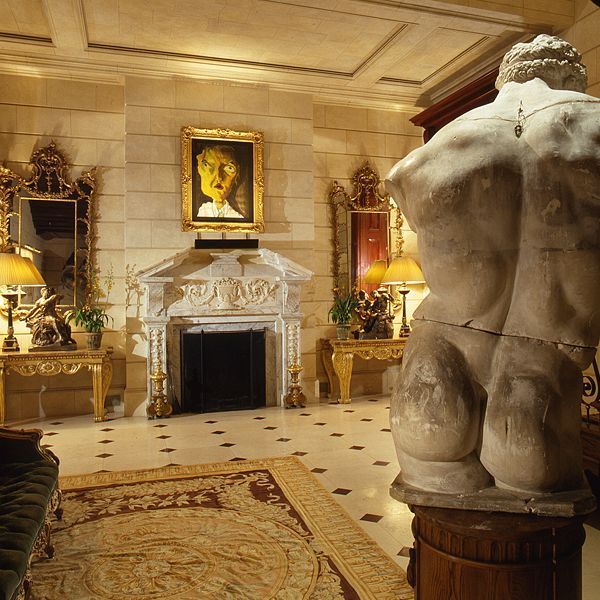
Now let’s get back to design. I’ve mixed together photos of the townhouse taken in 1993 and published in Architectural Digest 1995 of the work architect Thierry Despont and interior designer John Stefanidis did to convert it back into a residence for Les Wexner with others that show the changes Alberto Pinto made for Jeffrey Epstein.
When writer Vicky Ward visited, she made these observations for Vanity Fair, “On Manhattan’s Upper East Side, home to some of the most expensive real estate on earth, exists the crown jewel of the city’s residential town houses. With its 15-foot-high oak door, huge arched windows, and nine floors, it sits on—or, rather, commands—the block of 71st Street between Fifth and Madison Avenues. Almost ludicrously out of proportion with its four- and five-story neighbors, it seems more like an institution than a house. This is perhaps not surprising—until 1989 it was the Birch Wathen private school. Now it is said to be Manhattan’s largest private residence.”
“The entrance hall is decorated not with paintings but with row upon row of individually framed eyeballs; these, the owner tells people with relish, were imported from England, where they were made for injured soldiers. Next comes a marble foyer, which does have a painting, in the manner of Jean Dubuffet … but the host coyly refuses to tell visitors who painted it. In any case, guests are like pygmies next to the nearby twice-life-size sculpture of a naked African warrior.”

It’s clear from the Picasso on the second floor landing from 1993 that Les Wexner had much better taste in art than Jeffrey Epstein.
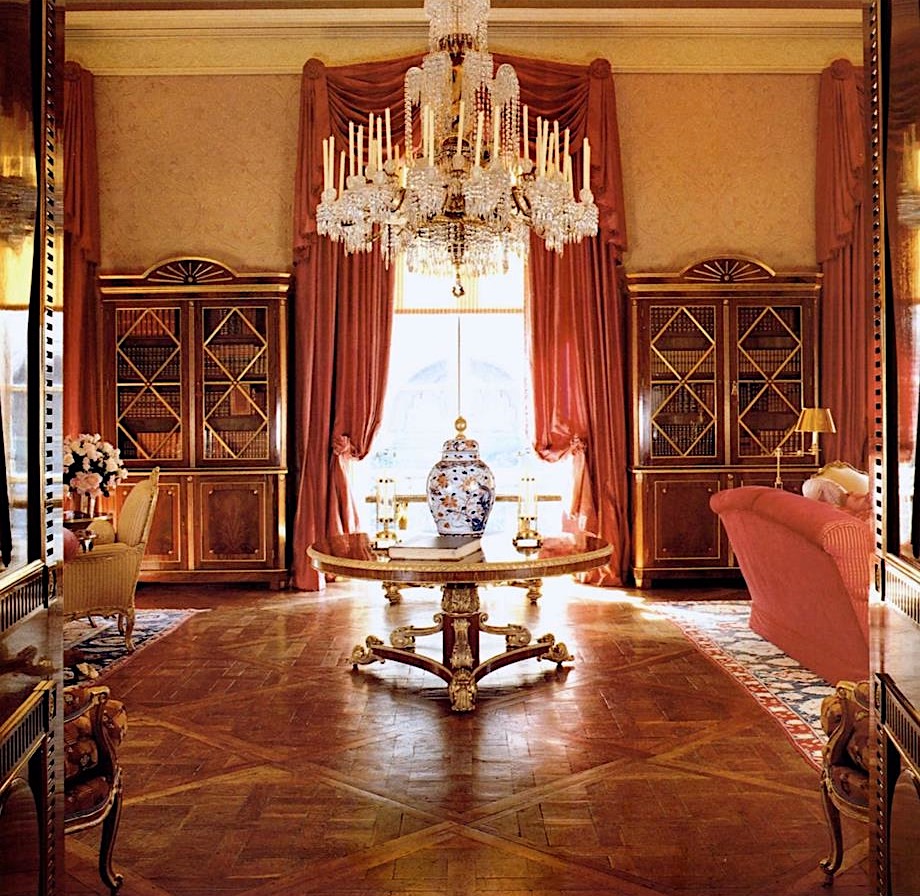
“A pair of 18th-century mahogany and brass mounted Russian bookcases bracket a living room window. Centering the 18th-century French parquet de Versailles floors is an English rosewood and gilt table.”

Photos of the townhouse when Jeffrey Epstein owned it surfaced around the time that Alberto Pinto passed away in 2012. This is a same view of the living room as above.
From Vanity Fair in 2003: “Upstairs, to the right of a spiral staircase, is the “office,” an enormous gallery spanning the width of the house. Strangely, it holds no computer. Computers belong in the “computer room” (a smaller room at the back of the house), Epstein has been known to say. The office features a gilded desk (which Epstein tells people belonged to banker J. P. Morgan), 18th-century black lacquered Portuguese cabinets, and a nine-foot ebony Steinway “D” grand. On the desk, a paperback copy of the Marquis de Sade’s The Misfortunes of Virtue was recently spotted. Covering the floor, Epstein has explained, “is the largest Persian rug you’ll ever see in a private home—so big, it must have come from a mosque.” Amid such splendor, much of which reflects the work of the French decorator Alberto Pinto, who has worked for Jacques Chirac and the royal families of Jordan and Saudi Arabia, there is one particularly startling oddity: a stuffed black poodle, standing atop the grand piano. “No decorator would ever tell you to do that,” Epstein brags to visitors. “But I want people to think what it means to stuff a dog.” People can’t help but feel it’s Epstein’s way of saying that he always has the last word.”
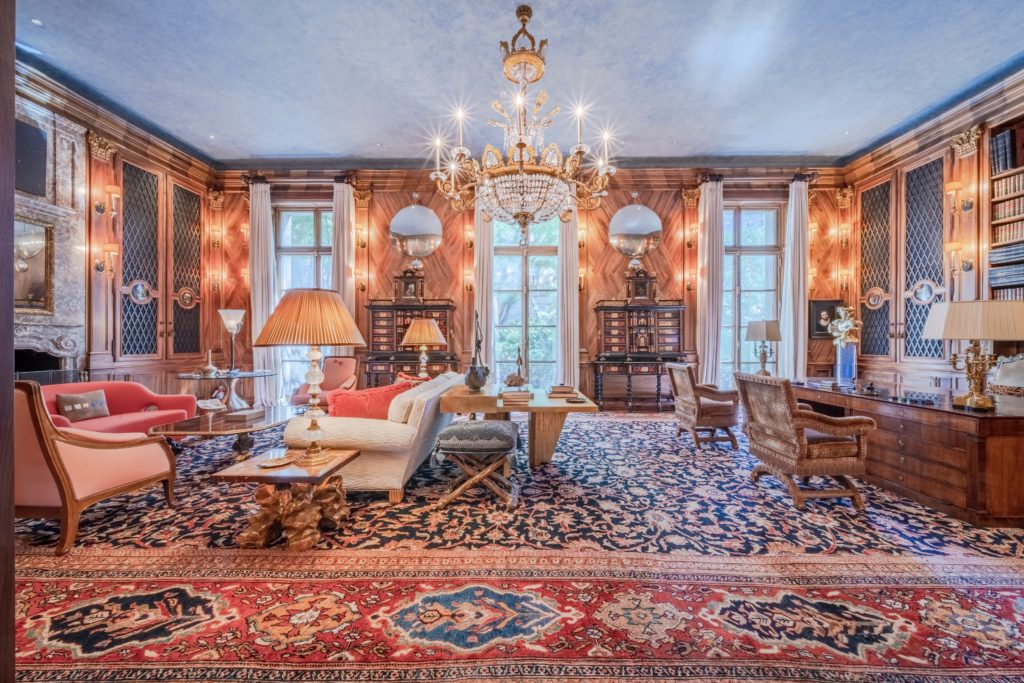
I’m not sure when the living room had a refresh but the work looks like it could have been done by Thierry Despont since the paneling and bookcases reminds me of the work he did in the Cartier townhouse renovation. The 18th-century black lacquered Portuguese cabinets, chandelier, and Persian rug, and tapestries shown in another photo remain the same from the previous incarnation.
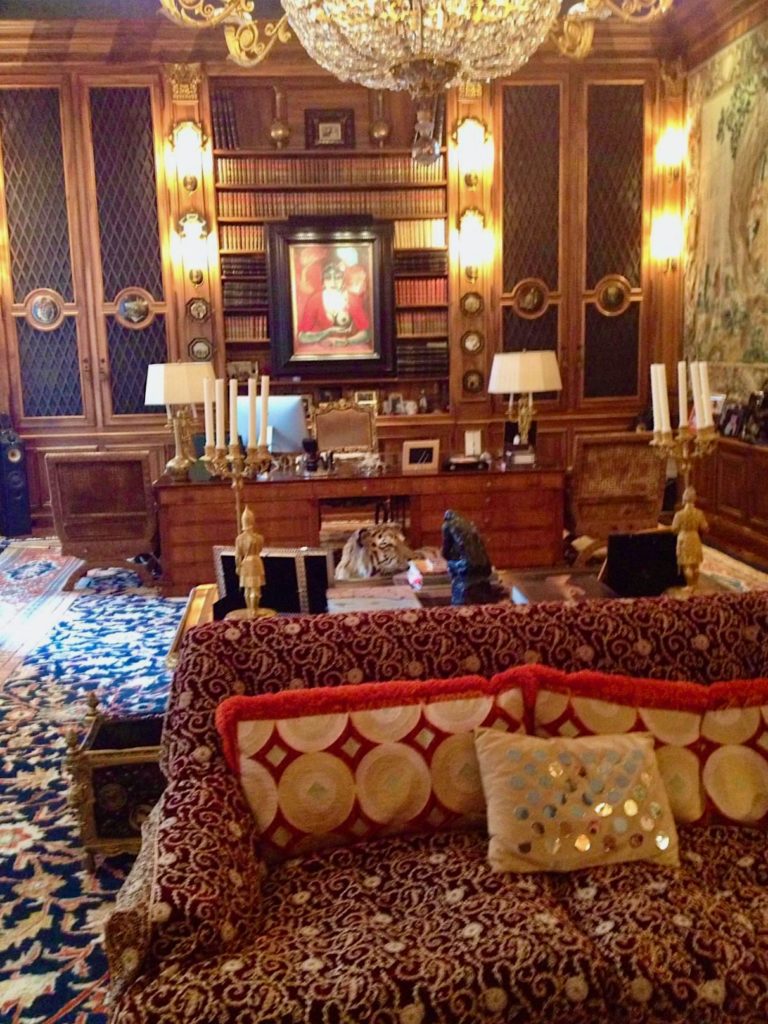
In this candid photo, it looks like Jeffrey Epstein did start working in this room as there is a computer on the desk.

This is another look at Jeffrey Epstein’s living room from when it was first decorated by Alberto Pinto.
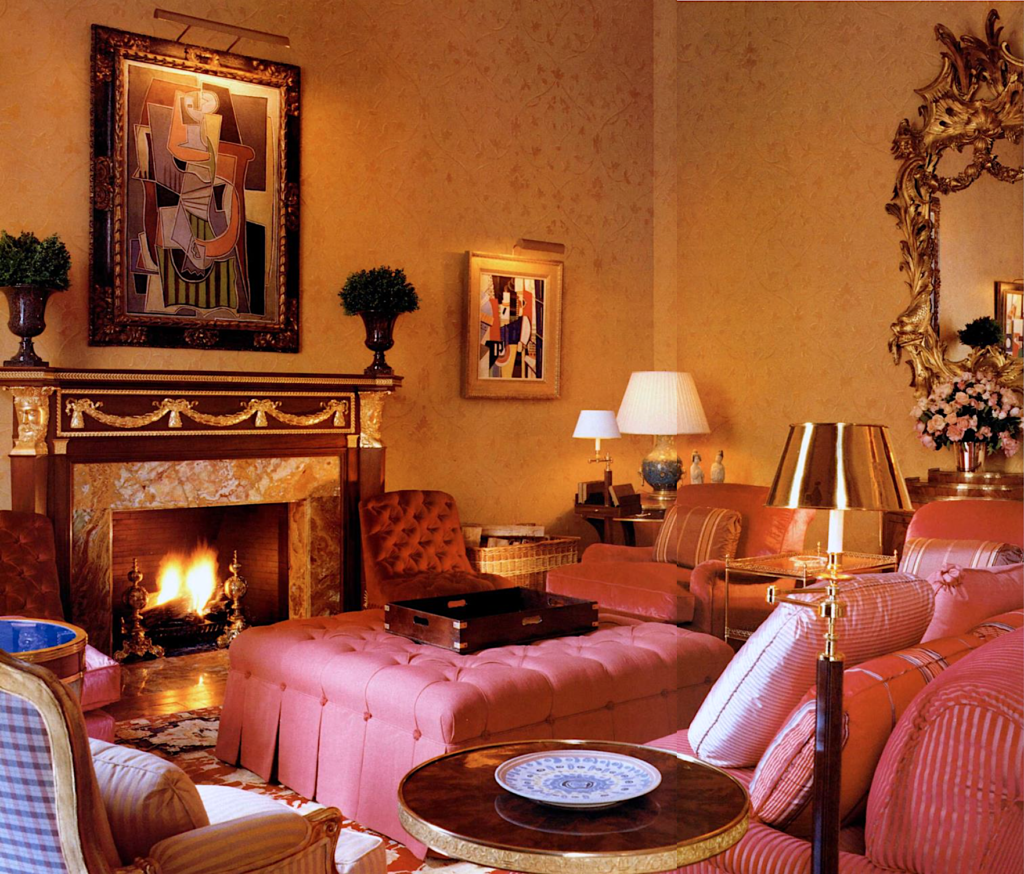
This view of the living room John Stefanidis designed for Les Wexner. He told Architectural Digest in 1995, “A townhouse in the Beaux Arts tradition is grand architecture, but grand does not have to mean pompous. The original living room probably had brocade-walls, heavy velvet draperies and very serious large picture set in massive gold frames. Now the stenciling is a lighthearted reference to that somber brocade, the exuberant pink draperies are of a light silk taffeta, and the client’s modern paintings have such quality that it emanates to the whole room.”
There were five men at work on the stenciling in the living room, first measuring carefully so the repeats of Italianate pattern would fit exactly, then trying samples of different sizes and colors, finally outlining each stenciled arabesque by hand to give relief, highlights, and detail.
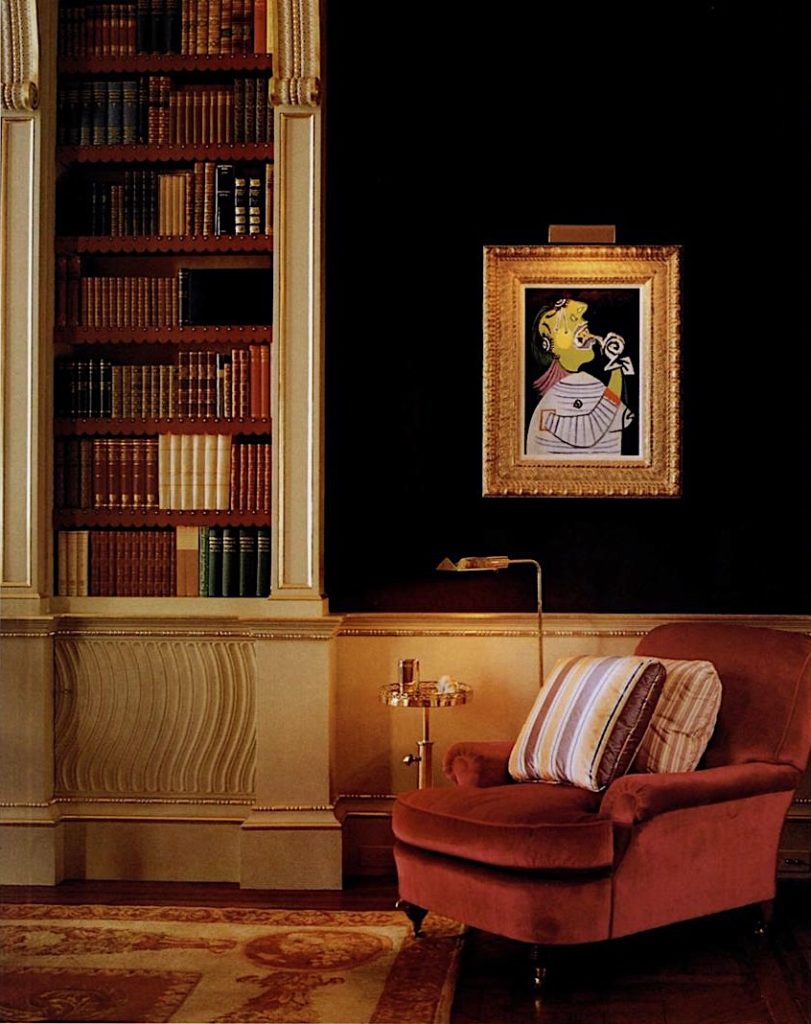
According to AD, John Stefanidis’s project for Les Wexner “began with the paintings, the Russian antiques, and the French Art Deco furniture in the client’s collection. The architect, Thierry Despont, entirely gutted the house and, with reference to the Russian antiques, based his designs for the new doors and fireplaces on those of Russian palaces. Despont and Stefanidis planned new rooms around a central staircase, and together they installed 18th-century French floors of oak parquet de Versailles, created a room specifically to fit some remarkable Art Deco paneling and designed ceilings inspired by Robert Adam.
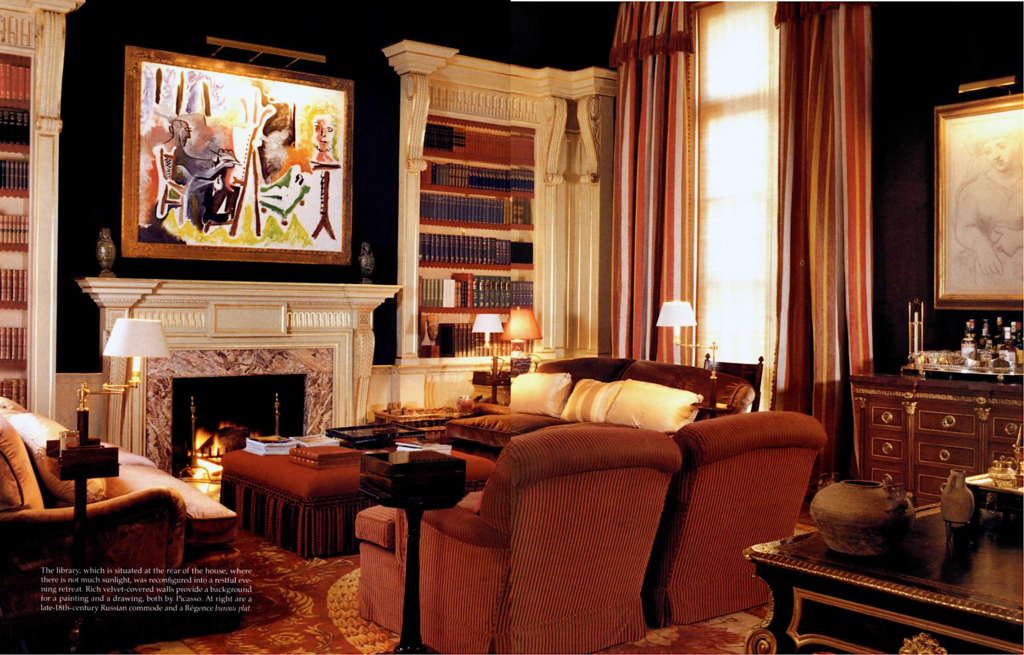
Work on Les Wexner’s townhouse lasted for two years. International teams of craftsmen were brought in, and Stefanidis was in the thick of it all, speaking Italian to the plasterers, French to the joiners, both languages to the painters, and nudging along what was a very cooperative artistic process. Colors, proportions, and scale were all assessed on the spot. “I don’t make final decisions in my office in London. Something may be on the plan, but if we get to the project and it doesn’t look right, it gets changed.”
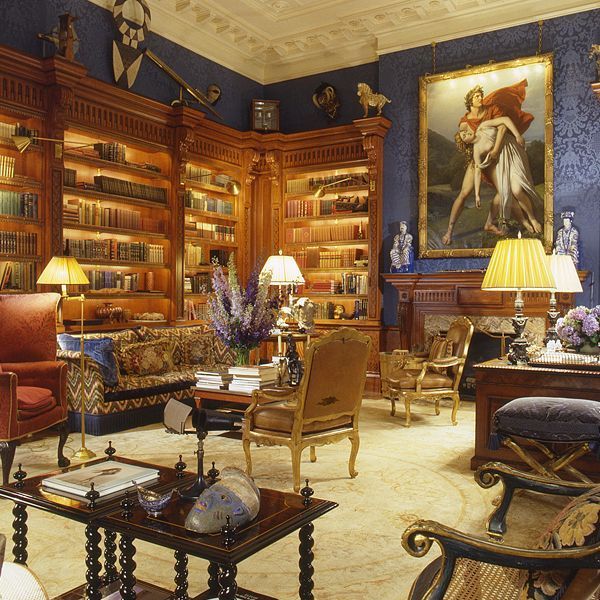
Alberto kept the library bookcase that Thierry Despont fashioned after the ones created by Robert Adams for Syon House outside of London but stripped them and the mantle of their paint.
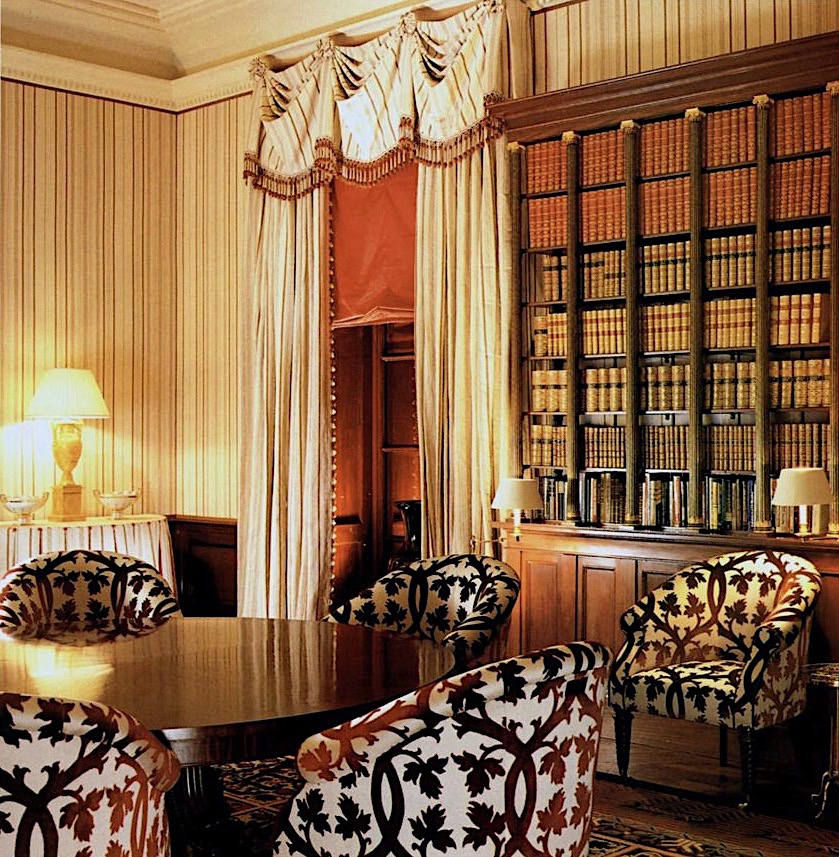
Light was part of the decision to create large rooms for entertaining at the front of the house, where sunshine pours in, and smaller rooms for quiet evenings at the rear of the house. In the darker rooms, mirrors panel the shutters, recusing light and returning it to the room. “It’s a quiet room, not a typical dining room but more like a library, with a large table for spreading books out,” said Stefanidis. The walls are swathed in silk and the French mahogany bookcase, with gilt-bronze mounts on fluted column supports, dates to circa 1820. The chairs upholstered in Clarence House fabric would be reupholstered in leopard print by Alberto Pinto for Jeffrey Epstein. See below.

From Vanity Fair: “Guests are invited to lunch or dinner at the town house—Epstein usually refers to the former as “tea,” since he likes to eat bite-size morsels and drink copious quantities of Earl Grey. (He does not touch alcohol or tobacco.) Tea is served in the “leather room,” so called because of the cordovan-colored fabric on the walls. The chairs are covered in a leopard print, and on the wall hangs a huge, Oriental fantasy of a woman holding an opium pipe and caressing a snarling lionskin. Under her gaze, plates of finger sandwiches are delivered to Epstein and guests by the menservants in white gloves.”

Jeffrey Epstein in his townhouse dining room in 2015 in a photo by Christopher Anderson for the New York Magazine article Who Was Jeffrey Epstein Calling?. Via The New York Times, “A person who visited the townhouse last year remembered Mr. Epstein doing work at the mansion while seated at a large dining table that fit 20 people, with multiple computer monitors and a phone alongside.”
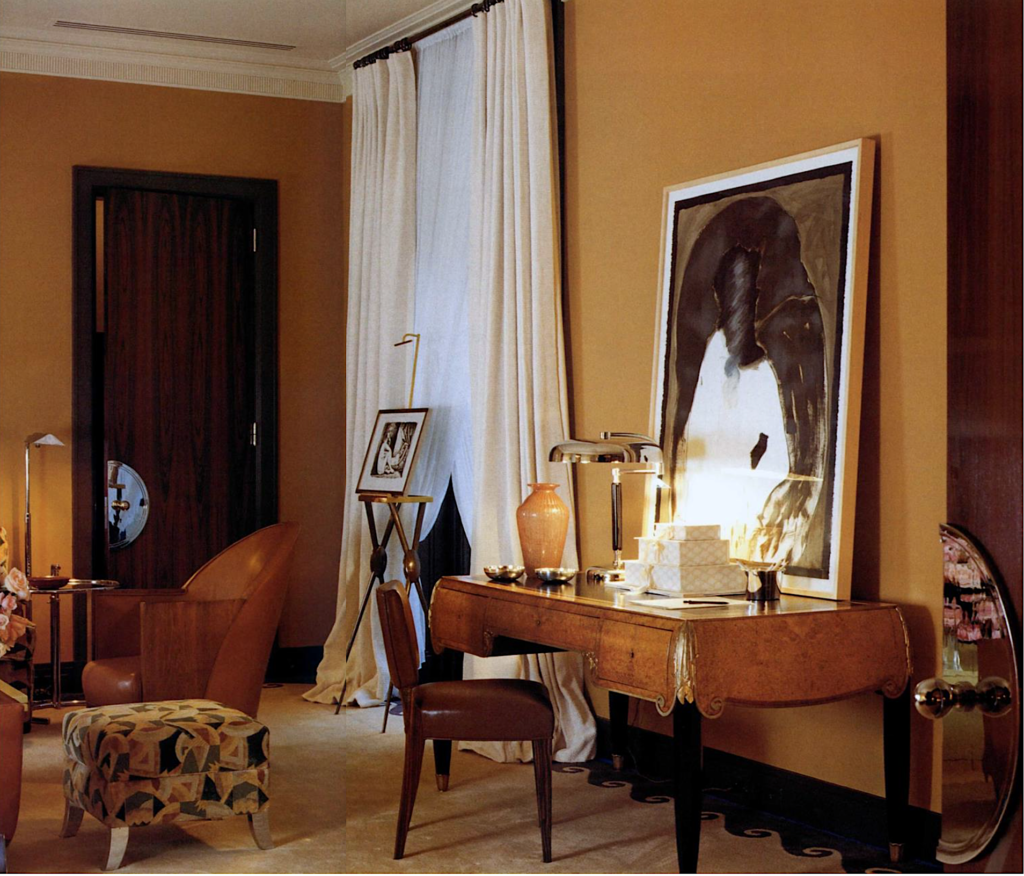
An Art Deco sitting room is part of a guest suite. At left is an Emile-Jacques Ruhlmann armchair and the desk is by Süe et Mare. The doors are made of rosewood with silver-plated hardware. The ottoman is upholstered in Clarence House fabric.
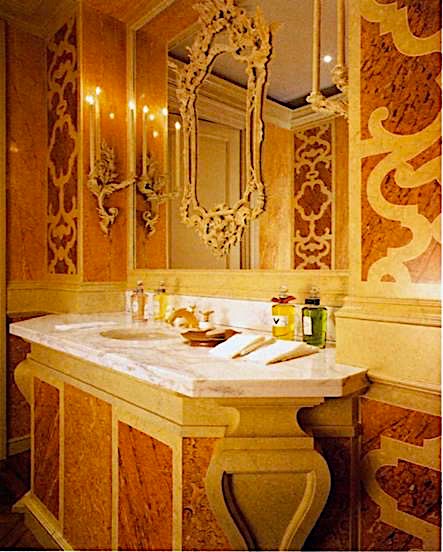
The second floor powder room is one of two that symmetrically flank the central staircase. Renaissance marble inlay inspired its intricate faux marble panels. The hand carved mirror frame was crafted in Venice.
Stefanidis avoids the predictable and prefers the occasional eccentricity because that makes one look twice and because, as he says, “being conventional can be dull, both in conversation and in design.”
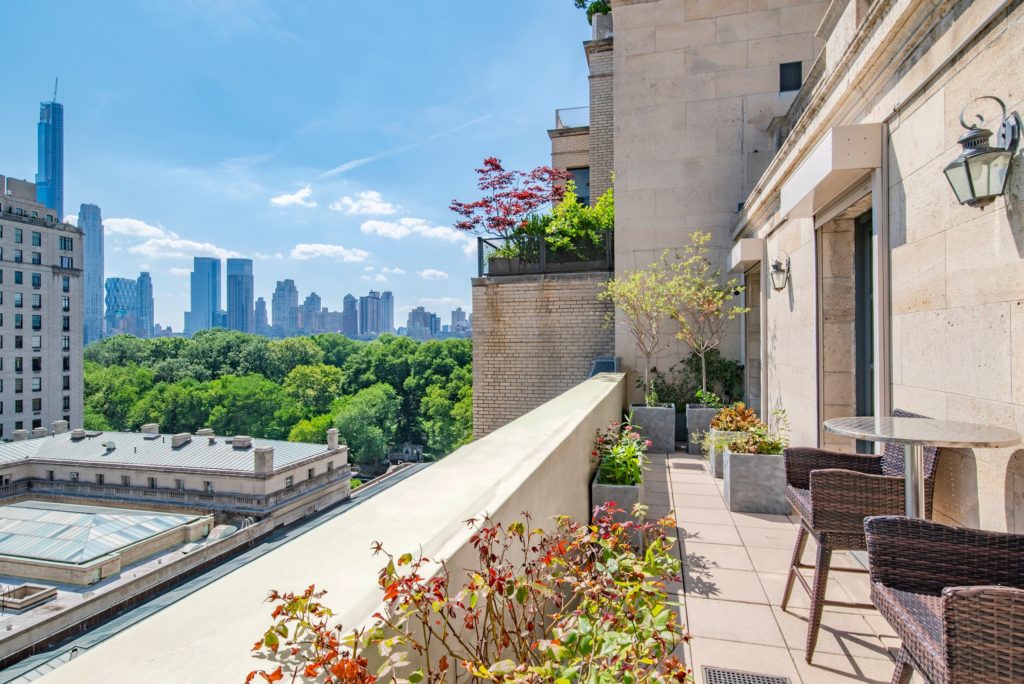
The terrace outside the bedroom suite on the top floor is one of only two new photos of Jeffrey Epstein’s townhouse that were included in the real estate listing from the Modlin Group. The boxes above the doors are for storm shutters that were probably also part of the elaborate security system installed by Les Wexner and added onto by Jeffrey Epstein.

I read somewhere that the master bathroom sits below the roof skylight.
The seven-story townhouse sits between Fifth and Madison Avenues is one of the largest private homes in Manhattan. It is a desirable 50 feet wide with a 102.2 foot deep lot and has an excess of 28,000 square feet. There are 40 rooms including ten bedrooms which include three-room suites on the fourth floor, 15 bathrooms, a two-story reception room, and a heated sidewalk in front to melt the snow during the winter months. Not to mention lots of bad juju. It’s listed for $88 Million which is more than it was estimated to be worth and more than it’s valued for property taxes but the money will go tot benefit Epstein’s victims so I hope someone buys it for that price.
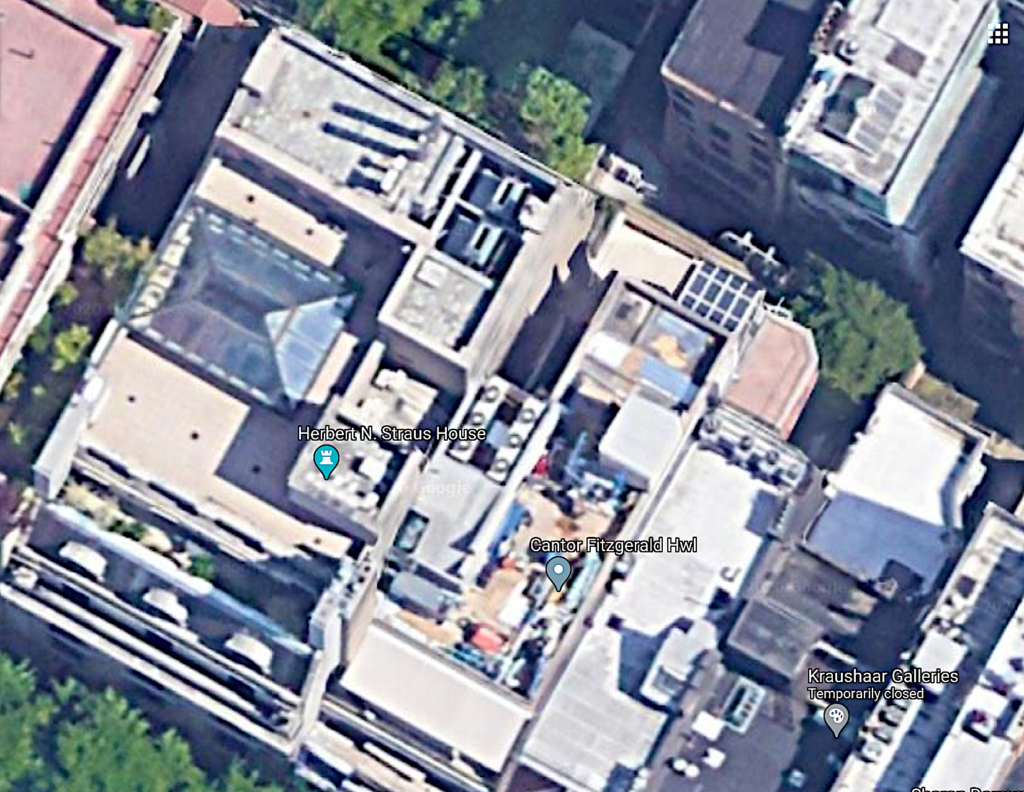
One final story. When I was in Paris over Thanksgiving 2013, I met up with a lot of friends who were also in the City of Light that week. I met up with one friend for dinner before her husband arrived and after he arrived, I met them both at a cafe for lunch one day. They were with another couple, NASCAR driver Brian Vickers and his wife Sarah. He was incredibly nice but she was a bit standoffish. I remember admiring her her belted fur coat and thinking that she lived a very enviable life. After lunch, we walked over to Notre Dame and took photos which was where I left them. I’d occasionally think of that trip when I saw Brian Vickers on tv in a commercial for Xarelto but that was it. Cut to 2019 when I see on the news that Sarah Kellen Vickers was allegedly one of the women who used to recruit girls for Jeffrey Epstein. This is another life lesson that the grass is never greener on the other side and you never know what’s going on behind the scenes or behind the 15-foot tall oak entry doors on a multi-million dollar townhouse on the Upper East Side.
from Habitually Chic®
No comments:
Post a Comment